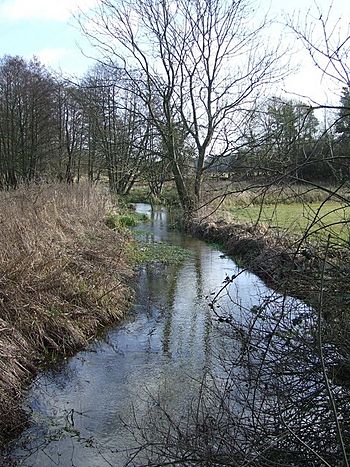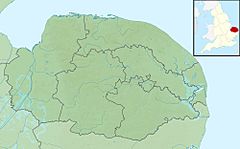River Gadder facts for kids
Quick facts for kids River Gadder |
|
|---|---|

River Gadder at Cockley Cley
|
|
|
Location of within Norfolk
|
|
| Country | England |
| State | Norfolk |
| Region | East of England |
| District | Breckland |
| Physical characteristics | |
| Main source | 0.6 miles (0.97 km) north-east of Home Farm Cockley Cley, Breckland 52°36′58.82″N 0°52′43.36″E / 52.6163389°N 0.8787111°E |
| River mouth | River Wissey 52°33′58″N 0°33′29″E / 52.56612°N 0.558124°E |
| Length | 10.4 km (6.5 mi) |
The River Gadder is a small river in Norfolk, England. It flows for about 10.4 kilometers (6.5 miles). The Gadder starts as a tiny stream in a wet meadow. This meadow is located near Cockley Cley in the north-east part of the parish.
Contents
The River's Journey
From where it begins, the River Gadder flows south-west. It travels through a shallow valley. This valley is surrounded by the unique breckland landscape. The river then reaches the village of Cockley Cley.
The Gadder flows along the southern edge of Cockley Cley. It creates a safe home for many wild animals and plants. The grassy areas along the river are protected. This is part of a special plan called the Environmentally Sensitive Area (ESA) scheme. You can see different kinds of fish in the river's clear water. These include stickleback, bullhead, and brown trout.
Gooderstone Water Gardens: A Beautiful Stop
Further downstream, the river arrives at Gooderstone. The village actually got its name from the river! In 1970, a retired farmer named Billy Knights created the Gooderstone Water Gardens. He turned a wet meadow next to the river into these amazing gardens.
The gardens cover about 6.5 acres (2.6 hectares). They feature four ponds and many waterways. There are also 13 bridges to cross. You can walk on flat grassy paths. The gardens have mature trees, shrubs, and colorful bog plants. There are also many beautiful flowers. Visitors can enjoy a tearoom, buy plants, and use accessible toilets. There are also many places to sit and relax. An 8.5-acre (3.4-hectare) area is set aside for wildlife. It even has a special hide where you might spot a kingfisher.
Oxborough and Historic Oxburgh Hall
The River Gadder then flows towards Oxborough. Here, the river's water helps fill the moat around Oxburgh Hall. This historic hall is now looked after by the National Trust.
Oxburgh Hall was built around 1482 by Sir Edmund Bedingfield. It has always been a family home, not a strong fortress. The Bedingfeld family gained control of Oxburgh before 1446 through marriage. They have lived in the house continuously since it was built in 1482. This was when Edward Bedingfeld received permission to add battlements to the building.
After flowing for about 6.4 miles (10.3 kilometers), the River Gadder joins the River Wissey. It connects to the Wissey on its northern bank, close to a place called Oxborough Hythe.
Gallery



